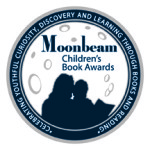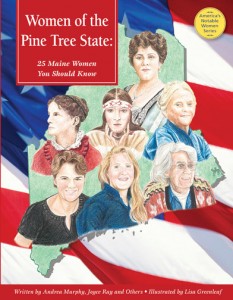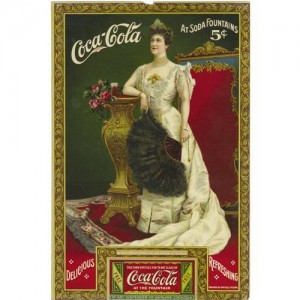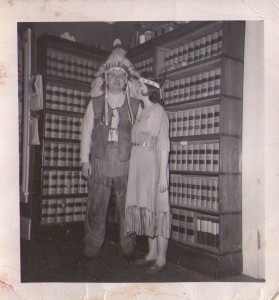 Women of the Pine Tree State: 25 Maine Women You Should Know is the seventh book I contributed to in this award-winning series on notable American women from Apprentice Shop Books. It is the first book in the series on which I am a lead author. I found every woman I’ve written about for Apprentice Shop endlessly fascinating, but the New England girls have a special place in my heart.
Women of the Pine Tree State: 25 Maine Women You Should Know is the seventh book I contributed to in this award-winning series on notable American women from Apprentice Shop Books. It is the first book in the series on which I am a lead author. I found every woman I’ve written about for Apprentice Shop endlessly fascinating, but the New England girls have a special place in my heart.
I profiled Margaret Wise Brown, Barbara Cooney, Cornelia “Fly Rod” Crosby, Mary Alice  “Molly Spotted Elk” Nelson, and Lillian Nordica for Women of the Pine Tree State.
“Molly Spotted Elk” Nelson, and Lillian Nordica for Women of the Pine Tree State.
When I chose my women to write about, I didn’t think I could love any of them more than I already loved Margaret Wise Brown. Margaret, who just may have written the perfect picture book when she wrote Goodnight Moon, was a picture book goddess. Who knew I would come to adore all those Maine women equally?
Research always leads to at least two or three I-didn’t-know-that moments, which makes me all out-of-proportion happy. What makes me really happy is when I discover something that isn’t common knowledge about one of my subjects. Take Barbara Cooney, author/illustrator extraordinaire. I read an interview with Cooney in the December 3, 1950 issue of The Lowell Sun in which she revealed she had attended school for practical nursing. How obscure is this tidbit? So obscure that Barbara’s own son Barnaby, who I interviewed in researching Cooney, had no idea his mother had trained as a nurse.
Cornelia “Fly Rod” Crosby defied every odd she came up against. Cornelia was so sick as a young child her death would not have been unexpected. Not only did she survive her childhood TB, she postponed death until the day after her 93rd birthday. She also excelled in a traditionally male field — hunting and fishing. She was so good at the woods, she received the first Maine Hunting and Fishing Guide license issued. Fly Rod is such a legendary figure she even had a song written about her.
 Lillian Nordica was a diva before Beyoncé was a twinkle in her great-grandfather’s eye. She was so popular she was the face of Coca-Cola from 1904 to 1905. Parisian designers named a color after her. A color! I don’t see “Beyoncé” in a box of Crayolas. The little girl from Farmington, Maine had one of the great voices of all time. Nordica’s death was as big as her life. Lillian had just embarked on a concert tour of Pacific countries when she was shipwrecked. She became ill and died on the Indonesian island of Java. Top that, Lady Gaga.
Lillian Nordica was a diva before Beyoncé was a twinkle in her great-grandfather’s eye. She was so popular she was the face of Coca-Cola from 1904 to 1905. Parisian designers named a color after her. A color! I don’t see “Beyoncé” in a box of Crayolas. The little girl from Farmington, Maine had one of the great voices of all time. Nordica’s death was as big as her life. Lillian had just embarked on a concert tour of Pacific countries when she was shipwrecked. She became ill and died on the Indonesian island of Java. Top that, Lady Gaga.
The woman I was most eager to learn about was Mary Alice “Molly Spotted Elk” Nelson. Molly was a Penobscot woman born on Indian Island near Old Town. Her dancing would carry her to Paris, where her talent was celebrated.
Her life was marked with incredible highs and tragic lows, and I found myself weeping as I wrote the final words of Molly’s story.
I was interested in Molly’s life because there is a good chance she knew my father. He  was one of the first, if not the first, attorneys to represent the Penobscots in their bid for recognition as a separate nation. (See this New York Times article about my father and the Penobscots.) My father had served in the Marines during World War II with John Mitchell, the Penobscot’s Lieutenant Governor. It was Mitchell who brought my father to Indian Island and introduced him to the tribal elders who requested he take on their case.
was one of the first, if not the first, attorneys to represent the Penobscots in their bid for recognition as a separate nation. (See this New York Times article about my father and the Penobscots.) My father had served in the Marines during World War II with John Mitchell, the Penobscot’s Lieutenant Governor. It was Mitchell who brought my father to Indian Island and introduced him to the tribal elders who requested he take on their case.
The relationship my father had with the Penobscot people was so deep they made him and my mother honorary Penobscots, gifted them with tribal garb, and christened my father Chief Legal Eagle. He would have been traveling regularly to Indian Island during the late 1950s when Molly was living there. I bet their paths crossed. I think they would have liked each other.
